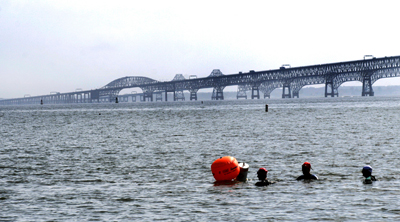
 |

|

By JAMES B. HALE
Capital News Service
Tuesday, October 6, 2009
ANNAPOLIS - Megan Brubaker dove into the Choptank River in Cambridge for the ChesapeakeMan Ultra Distance Triathlon last month, well aware of the high levels of pollution in the bay, but with no concerns for her health.
Unlike Brubaker, some Maryland residents are terrified at the prospect of swimming in the Chesapeake Bay. But scientists and regular bay swimmers assure there are little to no negative side effects of taking a dip in the water -- as long as you do it at the right time.
"In most cases, [the Maryland Department of the Environment] suggests you don't swim (for) 48 hours after a heavy rainfall," said Heath Kelsey, a scientist with the University of Maryland Center for Environmental Science. Otherwise, there are no concerns, he said.
But the consequences of swimming during that 48-hour window can be dire, according to a report released by the Chesapeake Bay Foundation in July. The Bad Water report warns of several harmful bacteria in the bay, including an especially dangerous variety called Vibrio, which can infect the skin, blood and intestines, often through open wounds.
Cases of Vibrio infections in Maryland have been on the rise, from 18 in 2001 to 33 in 2008, according to the report. Infections have resulted in 22 deaths in that time.
Bacteria can rapidly multiply after heavy rainstorms that run off into the bay from farms and city streets, bringing harmful chemicals and other pollutants, said Kelsey. He said the sicknesses and deaths are rare occurrences and people are not usually susceptible to harm.
"I guess it's like anything. When you're outside there are some things that harm you," said Kelsey. "I don't see this as prohibitive of swimming."
Brad Aupke, a 17-year-old student at Richard Montgomery High School in Rockville, said he remembers when officials closed Sandy Point beach in Annapolis in 2006 after finding high levels of bacteria. The closure and constant reminder of pollution levels since then typically make him nervous to swim.
As he fished in the waters of the Choptank River, he said it would take a lot to convince him to actually get into the bay.
"[Environment officials] would have to get in there and clean it themselves," Aupke said.
Aside from chemical pollutants, he said, he regularly sees trash in the water. He's usually fine swimming at public beaches, but the open bay is a completely different story.
Robert Vigorito, organizer of the ChesapeakeMan race and president of the Columbia Triathlon Association, said fears like Aupke's are unfounded. Swimming in the polluted bay is just as bad as walking around in the polluted air, he said.
Vigorito, who also participated in the race last month, said he's been swimming in the bay for 17 years. He's never had any health problems and neither has anybody else he knows, he said.
"If it was that polluted, fish would be dead, it would be a dead sea," he said.
If any of the triathletes had a concern about the water, they certainly didn't let it stop them from racing. Competition was fierce, and aside from a few jellyfish, said Brubaker, there weren't any problems.
She has been in lakes, ponds and rivers across the country and a few have scared her off, she said. The Chesapeake Bay is certainly not one of them.
"I didn't feel it was particularly gross and dirty by any stretch," Brubaker said. "Yeah it smells like gross fish, but what body of water doesn't?"